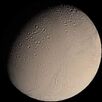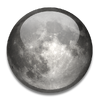The moons of Saturn are numerous and diverse,[1] ranging from tiny moonlets less than 1 kilometer across to the enormous Titan, which is larger than the planet Mercury. Saturn has 62 moons with confirmed orbits, 53 of which have names and only 13 of which have diameters larger than 50 kilometers, as well as dense rings with complex orbital motions of their own.[2][3][4] Seven Saturnian moons are large enough to be ellipsoidal in shape, yet only two of those, Titan and Rhea, are currently in hydrostatic equilibrium. Particularly notable among Saturn's moons are Titan, the second-largest moon (after Jupiter's Ganymede) in the Solar System, with a nitrogen-rich Earth-like atmosphere and a landscape featuring dry river networks and hydrocarbon lakes found nowhere else in the solar system;[5] and Enceladus since its chemical composition is similar to that of comets.[6] In particular, Enceladus emits jets of gas and dust which could indicate presence of liquid water under its south pole region and could potentially harbor a global ocean under its surface.[7] Twenty-four of Saturn's moons are regular satellites; they have prograde orbits not greatly inclined to Saturn's equatorial plane.[8] They include the seven major satellites, four small moons that exist in a trojan orbit with larger moons, two mutually co-orbital moons and two moons that act as shepherds of Saturn's F Ring. Two other known regular satellites orbit within gaps in Saturn's rings. The relatively large Hyperion is locked in a resonance with Titan. The remaining regular moons orbit near the outer edge of the A Ring, within G Ring and between the major moons Mimas and Enceladus. The regular satellites are traditionally named after Titans and Titanesses or other figures associated with the mythological Saturn. The remaining 38, all small except one, are irregular satellites, whose orbits are much farther from Saturn, have high inclinations, and are mixed between prograde and retrograde. These moons are probably captured minor planets, or debris from the breakup of such bodies after they were captured, creating collisional families. The irregular satellites have been classified by their orbital characteristics into the Inuit, Norse, and Gallic groups, and their names are chosen from the corresponding mythologies. The largest of the irregular moons is Phoebe, the ninth moon of Saturn, discovered at the end of the 19th century. The rings of Saturn are made up of objects ranging in size from microscopic to moonlets hundreds of meters across, each in its own orbit around Saturn.[9] Thus a precise number of Saturnian moons cannot be given, because there is no objective boundary between the countless small anonymous objects that form Saturn's ring system and the larger objects that have been named as moons. Over 150 moonlets embedded in the rings have been detected by the disturbance they create in the surrounding ring material, though this is thought to be only a small sample of the total population of such objects.[10]
Moons[]
| # | Moon | Name | Diameter | Radius | Disovered | Discoverer(s) |
|---|---|---|---|---|---|---|
| 1 | Mimas | 372 | 1,561 km | January 8, 1610 | Willam Herschel | |
| 2 | Enceladus | 398 | 2,634 km | January 7, 1610 | Willam Herschel | |
| 3 | Tethys | 4,852 | 1,822 km | January 8, 1610 | Giovanni Cassini | |
| 4 | Dione | 1,351 | 2,410 km | January 7, 1610 | Giovanni Cassini | |
| 5 | Rhea | 2,203 | 1 km | February 8, 2003 | Giovanni Cassini | |
| 6 | Titan | 6,256 | 2.7 km | November 25, 2000 | Christaan Hugyens | |
| 7 | Iapetus | 2,038 | 1 km | December 9, 2001 | Giovanni Cassini | |
| 8 | Pan | 36 km | 18 km | July 6, 1938 | Seth Barnes Nicholson | |
| 9 | Pandora | 16 km | 8 km | July 8, 1979 | Voyager 2 | |
| 10 | Altas | 42 km | 4 km | September 30, 1975 |






